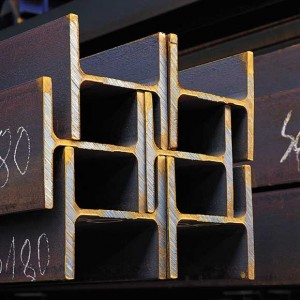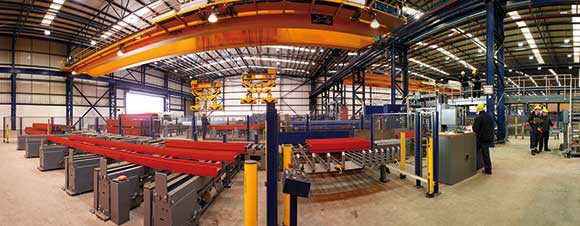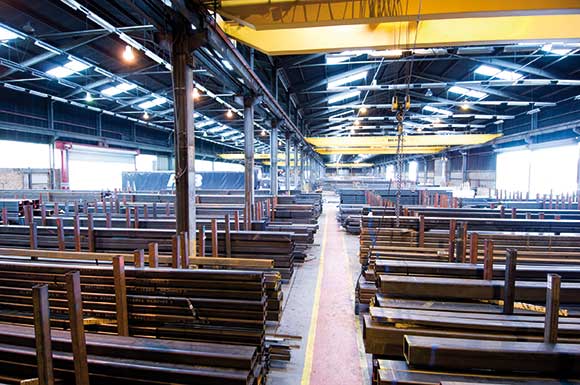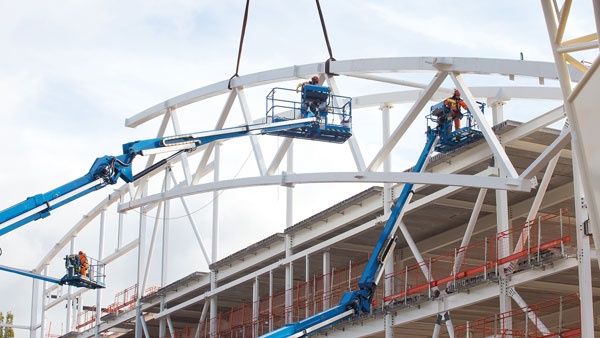Technical
Stockholders – the strategic resource
One of the best-organised distribution networks of any industrial product is at the service of the UK’s structural design community, in the shape of the national network of constructional steel stockholders. NSC explains their role in the first of a new series on the Steel Supply Chain.
Steel stockholders are little publicised yet play a vital part in the steel construction supply chain, ensuring the market is supplied with what it needs when it is needed. From an extensive national network of depots, steel stockholders serve all parts of UK industry, and construction is their biggest client. As well as heavy structural sections they provide plates, light sections, cladding materials, flats, angles – all the elements needed to create a steel building. Total stocks held are thought to represent at least 40 days supply, a vitally important strategic resource of national economic significance.
Part of the stockholder’s value to the construction industry stems from their close working relationship with Corus, the UK’s major steel manufacturer. Corus has a continuous programme of major investment in its world class plant and processes, providing high quality steels as well as improving service to customers. Corus produces steel in large quantities to keep the UK market supplied, but stoppages are needed occasionally for essential maintenance work, upgrade or repairs, which can give rise to gaps in the production schedule.

As well as sections, stockholders need to supply all the parts needed for a steel building (Photo courtesy of ASD Metal Services)
Stockpiling ensures continuity of supply when production is interrupted, and eliminates risks of disruption to customers. The new Automated Distribution Centre at Corus’ Scunthorpe works for example can hold up to 17,000 tonnes of steel sections at any one time, and stockholders provide a vital back-up resource of their own.
The service does not end with simply supplying steel, and the role of the stockholder in processing steel has grown substantially in recent years. Some stockholders liken their service to a Steel Service Centre. Like the rest of the steel construction supply chain stockholders have invested heavily in productivity and service enhancing equipment and computer controlled stock control and distribution processes. Some have invested in the latest sawing machinery for example, and more environmentally friendly shotblasting and priming equipment. Stockholders are also investing in state of the art equipment such as laser cutting machines that can cost £5M or more.
Outside observers might suspect that this puts stockholders in competition with their steelwork contractor customers who traditionally carry out processing work, but their services are recognised as making the supply chain more efficient, producing savings that can be shared with end users. All parts of the supply chain benefit from this.
Recognition is given to the following stockholders which are supporting the BCSA/Corus steel construction market development programme:ASD metal services
Austin Trumanns Steel Ltd
Barrett Steel Ltd
Corus
National Tube Stockholders Ltd
NSD Ltd
Stockholders also have a bulk breaking role. As their name suggests, they buy in large volumes and hold vast stocks of steel so they can respond to the demands of customers for the hundreds of steel sections sizes and grades available.
The stockholder’s main customer is the steelwork contractor. In 2007 the UK construction industry used some 1.5Mt of structural steel and over 70% of that was sourced through stockholders. Most of that steel went through steelwork contractors, most of whom are BCSA members, as are many of the stockholders.
The mutual dependence that exists between the stockholders and their steelwork contractor customers is acknowledged by the holding of regular meetings and cooperation between them on key issues. The aim of joint activities is to better discover and meet the needs of the UK structural design community.
Some steelwork contractors of course buy direct from the mill, usually for specific projects involving exceptionally large or complicated steel sections. The factors that influence what percentage of a steelwork contractor’s steel is sourced from a stockholder or direct from the mill will vary over time and with the size and nature of the project. There will also be a lot of variation between steelwork contractors.
One of the major benefits to steelwork contractors of the stockholders is not having to hold expensive stocks of steel on the off chance that it may be demanded soon. Stockholders can do this much more economically as, having a lot of steelwork contractors to supply, they can turn their stock over much more quickly. The benefit to the end user of the steel is of course that they get the steel needed for the job at a much more economic price than would otherwise have been possible.

Stockholders have invested in sophisticated equipment such as state-of-the-art saws (Photo courtesy of ASD Metal Services)
Stockholders play a vital role and can adapt to changing times whether the construction industry is experiencing levels of high demand when time is of the essence, or in quieter periods. When building projects are thinner on the ground the construction buyers market means there will be a demand for speedier tendering and acceptances of jobs offered, and steelwork contractors will not feel able to wait for mills to roll the appropriate sections; in this economic climate stockholders will improve the availability of steel. When times are better or production cannot immediately catch up with a sudden and rapid rise in demand for a particular type or size of section, then the industry will be able to rely on steel held by stockholders. In essence, successful stockholding is all about making steel available quickly.
Initial consideration of the stockholders’ business model might lead observers to think that they might maximise turnover and hence profitability by simply having a minimum amount to hand of the most popular sections. But there is competitive advantage to be gained by developing a reputation as a supplier that will have what is needed when it is needed; time sensitive steelwork contractors will quickly learn who to turn to when the pressure is on and will know who to support with the rest of their business.
It is important for specifiers and designers to appreciate the extent of the resource that stockholders represent, providing them with assurance that steel will be available for their projects whatever the market conditions. They point to the extensive network of distribution depots that have been established nationally to ensure that local projects can be easily supplied on a just in time basis.
The service does not end with simply supplying steel. Like the rest of the steel construction supply chain stockholders have invested heavily in recent years in productivity and service enhancing equipment and computer controlled stock control and distribution processes. Some have invested in the latest sawing machinery for example, and more environmentally friendly shotblasting and priming equipment.
Most stockholders are now accredited to ISO9000. Investment has been made in delivery vehicles and safety innovations made in safe ways to unload when steel reaches either the fabrication yard or site.
The flexibility that the stockholder provide to the steel construction sector has meant they have been able to respond to construction industry demands for just in time deliveries for about 20 years. Designers can share the steelwork contractors’ confidence that stockholders will be able to supply what is needed at the right time. The large stocks held also mean that designers need not worry about designing in high quality steel grades (for open sections) like S355JR or S355JO and are not limited to S275JR (43A).












